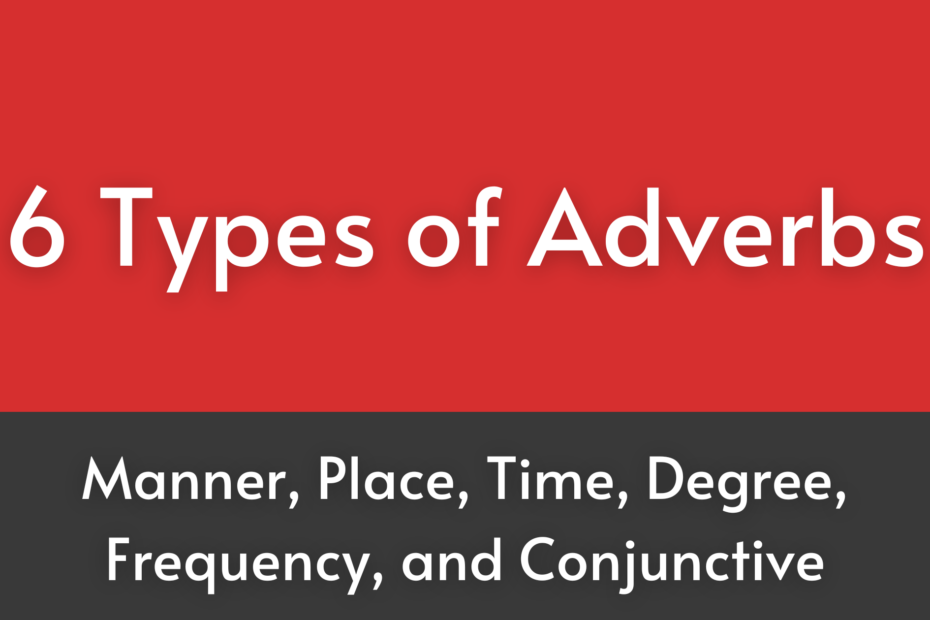There are 6 types of adverbs in the English language: manner, place, time, degree, frequency, and conjunctive. Each type of adverb has a different function and can be used in different ways.
Adverbs play an important role in the English language. They can be used to modify verbs, adjectives, and other adverbs. adverb. Here are 6 different types of adverbs:
- Adverbs of Manner
- Adverbs of Degree
- Adverbs of Frequency
- Adverbs of Time
- Adverbs of Place
- Conjunctive Adverbs
Adverbs of Manner
Adverbs of manner are words that modify verbs to describe how an action was done. For example, “He slowly walked away.” In this sentence, “slowly” is an adverb of manner that modifies the verb “walked.” Other examples of adverbs of manner include “quickly,” “happily,” “angrily,” and “sadly.”
Examples of Adverbs of Manner
- He ran quickly
- They happily ate the food.
- John wisely took an extra umbrella with him.
Adverbs of Degree
Adverbs of degree tell us how much, how strongly, or to what extent. They can be used to modify verbs, adjectives, and other adverbs. Here are five types of adverbs of degree in English, with examples:
- Adverbs of the degree of certainty: certainly, definitely, probably, hopefully
- Adverbs of the degree of magnitude or intensity: extremely, deeply, fairly, a bit, slightly
- Adverbs of the degree of order or rank: firstly, secondly, lastly; also, moreover
Examples of Adverbs of Degree
- It is extremely hot water.
- That Pen is much too expensive.
- He also gives me chocolate.
Adverbs of Frequency
Adverbs of frequency are words that describe how often something happens. There are five most common adverbs of frequency: always, usually, often, sometimes, and never.
- Always is used to describe something that happens all the time. For example, “I always brush my teeth before bed.”
- Usually is used to describe something that happens most of the time. For example, “I usually have breakfast before school.”
- Often is used to describe something that happens regularly. For example, “I often go for a walk after dinner.”
- Sometimes is used to describe something that doesn’t happen all the time. For example, “Sometimes I have a snack before bed.”
- Never is used to describe something that is not happening. For example, “I never go to a club”
Examples of Adverbs of Frequency
- I usually go to jam.
- John never drives on bumpy roads.
- Sometimes, she gets coffee for his colleagues.
Adverbs of Time
Adverbs of time can be used to describe when something happens, how long it takes, and how often it happens. Yesterday, today, and tomorrow are all adverbs of time. Each adverb of time has a different meaning. Adverbs of time are an important part of speech because they can add a lot of meaning to a sentence.
Examples of Adverbs of Time
- She is going to see a movie tomorrow.
- Recently, John got a job as a Police Officer.
- Today, the weather is not good.
Adverbs of Place
An adverb of place is a word that describes where the action is happening. For example, the word “outside” is an adverb for the place. Adverbs of place can be placed before or after the verb. For example, you can say “He ran outside” or “He outside ran .”
There are many adverbs of place that can be used in sentences. For example, “here”, “there”, “everywhere”, “nowhere”, “somewhere”, “anywhere”, “behind”, “in front of”, “beside”, “inside”, “outside”, “above”, “below”, “beyond”, “under”, “over”, “on”, “off”, “forward”, “backward”, “down”, “up”, and “around”.
Examples of Adverbs of Place
- I like to go outside my Home.
- She can’t find my book anywhere.
- The party is over there.
Conjunctive Adverbs
Conjunctive adverbs are words that join two independent clauses. They can be used to show a variety of relationships between the two clauses, including cause and effect, contrast, or similarity. Some common conjunctive adverbs are, however, nevertheless, nonetheless, otherwise, and therefore. In addition, conjunctive adverbs act like conjunction the sentence.
Here are some examples of conjunctive adverbs used in sentences:
- I’m doing my best, but I can’t do it alone
- We were late, so we missed the bus.
- However, she didn’t see the other car coming.
Conclusion
Adverbs are words that modify verbs, adjectives, and other adverbs. They are important in both writing and speaking because they help to add detail and clarify the meaning of a sentence. There are six types of adverbs: manner, place, time, degree, frequency, and conjunctive. Each type of adverb can be used to modify a different part of speech. Adverbs can be used to make a sentence more interesting and to add variety.

